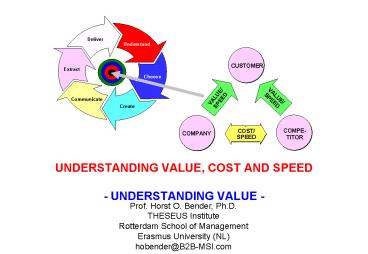UNDERSTANDING VALUE, COST AND SPEED UNDERSTANDING VALUE - PowerPoint PPT Presentation
1 / 19
Title:
UNDERSTANDING VALUE, COST AND SPEED UNDERSTANDING VALUE
Description:
UNDERSTANDING VALUE, COST AND SPEED - UNDERSTANDING VALUE - Prof. Horst O. Bender, Ph.D. ... Prof. Horst O. Bender, Ph.D. Rotterdam School of Management ... – PowerPoint PPT presentation
Number of Views:214
Avg rating:3.0/5.0
Title: UNDERSTANDING VALUE, COST AND SPEED UNDERSTANDING VALUE
1
UNDERSTANDING VALUE, COST AND SPEED-
UNDERSTANDING VALUE -
Prof. Horst O. Bender, Ph.D. THESEUS
Institute Rotterdam School of Management Erasmus
University (NL) hobender_at_B2B-MSI.com
2
UNDERSTANDING BENEFITS, VALUE AND VALUE
PROPOSITION
Technical
Quality
Service
Quality
Timing
Benefits
Quality
Value
Proposition
Reputation
Quality
Relationship
Quality
Price
3
MAPPING BENEFITS AND PRICE
High
Superior
Value
VALUE POSITION
Inferior
Value
Low
High
Low
PRICE
4
MANAGING DIFFERENTIAL ADVANTAGE
Technical
Quality
Service
Quality
Segment C
Timing
Quality
Segment B
Perceived Value
Reputation
Segment A
Quality
Relationship
Quality
CUSTOMER
Price
Technical
VALUE/ SPEED
VALUE/ SPEED
Quality
Service
Quality
Timing
Quality
COST/ SPEED
Value
Proposition
Reputation
Quality
Relationship
Quality
Price
COMPANY
COMPETITOR
5
MANAGING VALUE MIGRATION
- Key Points
- Value migrates
- It is important for a company to spot, understand
and adapt to these shifts - Examples
- From sugar to artificial sweeteners
- From typewriters to word processors
- From mainframes to minis to PCs to networks
- From stand-alone software to software suites
- From software in shrink-wrapped boxed to
software-on-demand - From large companies operating computer systems
to on-demand computing
6
MANAGING THE VALUE LADDER
Differentiated
Deliver Experiences
Responsive to
Organize the Network
Customization
Commoditization
Provide Solution
Customization
Customer
Commoditization
Competitive
Needs
Deliver Services
Position
Customization
Commoditization
Make and Sell Products
Customization
Commoditization
Extract Commodities
Undifferen- tiated
Irresponsive to
Pricing
Market
Premium
7
MANAGING VALUE VIA PRODUCT CONFIGURATION DEVICES
Customer Preference and Choice
Naked Product with Options Approach
Product Configuration Device
Modular Product/ Service Design
- Information and Customer Relationships Become
Strategic Assets
8
UNDERSTANDING COST
Prof. Horst O. Bender, Ph.D. Rotterdam School of
Management Erasmus University (NL) hobender_at_B2B-MS
I.com
9
MAPPING BENEFITS AND COST
Value and
Value
Superior
Cost Leader
Leader
BENEFITS POSITION
Competitive Parity
Cost
Inferior
Inferior
Leader
Position
Inferior
Superior
COST POSITION
10
MANAGING COST POSITION
Economies of scale and scope Supply
costs Learning-by-doing Product
re-design Elimination of non-value-adding
activities Business process management Operational
excellence
An 80 Percent Experience Curve
Linear Scale
Log - Log Scale
380
400
300
300
250
Cost or price per unit
200
Cost or price per unit
200
150
150
100
100
0
400
800
1200
1600
1800
Total accumulated production, units
0
200
400
800
1500
2000
Total accumulated production, units
11
EXAMPLES OF EXPERIENCE CURVES
Silicon transistors
1954
1960
1965
1972
50.00
10.00
Ave. price/unit
1.00
Constant money
(d)
0.10
0.01
0.10
1.0
10
100
1000
10.000
Industry cumulative volume (million units)
12
UNDERSTANDING COST POSITION VIA ACTIVITY-BASED
COSTING
- PRODUCTS CONSUME ACTIVITIES WHICH
- IN TURN CONSUME RESOURCES
- Is appropriate when overheads are a significant
cost factor - Allows us to understand which activities drive
costs - Focuses on the activities (materials and
information exchanges) that move production along
but dont directly produce products - Captures engineering change orders, material
releases, purchasing, logistics, warranty
clauses, and field service requests
13
UNDERSTANDING SPEED
Prof. Horst O. Bender, Ph.D. Rotterdam School of
Management Erasmus University (NL) hobender_at_B2B-MS
I.com
14
UNDERSTANDING SPEED POSITION
- Time to customerHow long does it take to capture
a customers order and to deliver or installthe
product to the customers satisfaction? - Time to marketHow long does it take the business
to recognize a market opportunityand to
translate this into a product or service and
bring it to the market? - Time to cash The cash-to-cash cycle is a
measure of the total cash that is locked up in
the pipeline from when materials or components
are purchased from suppliers to when the finished
product is sold and the cash received from
customers - Time to improveHow long does it take to achieve
a specific quality improvement? - Time to reactHow long does it take to adjust the
output of the business in response tovolatile
demand? Can the tap be turned off quickly? - RhythmTo what degree are the business
activities and processes synchronized?
15
TIME-TO-MARKET PROJECT RETURN MAP
Cost and Revenues (millions of dollars
1000
Sales
100
Profit
10
Investment
Break-Even-Time (BET)
1
Time-to-Market (TM)
Break-Even After Release (BEAR)
Development
Opportunity Recognized
6
12
18
24
30
36
Market Release
Time (Months)
Investigation
Source Charles H. House and Raymond L. Price
Harvard Business Review,
January-February 1991
Design Frozen
16
TIME-TO-CASH CASH-TO-CASH CYCLE
Purchase Raw Materials or Merchandise from
Supplier
Sell Product
Days Inventory
Days Receivables
Days Payable
Cash-to-Cash Cycle
Pay Supplier for Materials (Merchandise)
Collect Cash from Customer
17
MANAGING SPEED POSITION TIME-BASED STRATEGY
Lean Marketing
Time-Based Purchasing
Time-Based Strategy
Lean Manufacturing
Time-Based Logistics
Time-Based Innovation
18
DIAGNOSTICS
19
VALUE MAPPING - BENEFITS, PRICE AND COST
Position your product on the following matrices
VALUE MAPPING
High
Superior
Value
VALUE POSITION
Value and
Value
Inferior
Superior
Cost Leader
Leader
Value
BENEFITS POSITION
Competitive Parity
Low
High
Low
Cost
Inferior
Inferior
PRICE
Leader
Position
Inferior
Superior
COST POSITION































